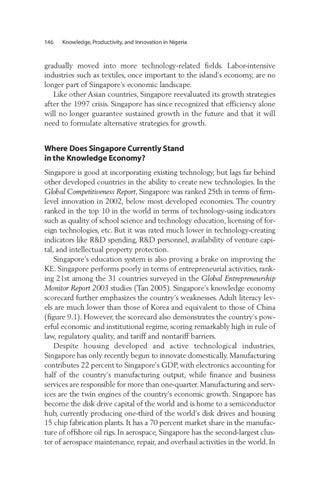146
Knowledge, Productivity, and Innovation in Nigeria
gradually moved into more technology-related fields. Labor-intensive industries such as textiles, once important to the island’s economy, are no longer part of Singapore’s economic landscape. Like other Asian countries, Singapore reevaluated its growth strategies after the 1997 crisis. Singapore has since recognized that efficiency alone will no longer guarantee sustained growth in the future and that it will need to formulate alternative strategies for growth.
Where Does Singapore Currently Stand in the Knowledge Economy? Singapore is good at incorporating existing technology, but lags far behind other developed countries in the ability to create new technologies. In the Global Competitiveness Report, Singapore was ranked 25th in terms of firmlevel innovation in 2002, below most developed economies. The country ranked in the top 10 in the world in terms of technology-using indicators such as quality of school science and technology education, licensing of foreign technologies, etc. But it was rated much lower in technology-creating indicators like R&D spending, R&D personnel, availability of venture capital, and intellectual property protection. Singapore’s education system is also proving a brake on improving the KE. Singapore performs poorly in terms of entrepreneurial activities, ranking 21st among the 31 countries surveyed in the Global Entrepreneurship Monitor Report 2003 studies (Tan 2005). Singapore’s knowledge economy scorecard further emphasizes the country’s weaknesses. Adult literacy levels are much lower than those of Korea and equivalent to those of China (figure 9.1). However, the scorecard also demonstrates the country’s powerful economic and institutional regime, scoring remarkably high in rule of law, regulatory quality, and tariff and nontariff barriers. Despite housing developed and active technological industries, Singapore has only recently begun to innovate domestically. Manufacturing contributes 22 percent to Singapore’s GDP, with electronics accounting for half of the country’s manufacturing output, while finance and business services are responsible for more than one-quarter. Manufacturing and services are the twin engines of the country’s economic growth. Singapore has become the disk drive capital of the world and is home to a semiconductor hub, currently producing one-third of the world’s disk drives and housing 15 chip fabrication plants. It has a 70 percent market share in the manufacture of offshore oil rigs. In aerospace, Singapore has the second-largest cluster of aerospace maintenance, repair, and overhaul activities in the world. In
